Inadequate Governance of Urban Ecosystems in Lahore, Pakistan: Insights from Changes in Land Use
Abstract
1. Introduction
2. Materials and Methods
2.1. Study Area
2.2. Primary Data Collection
2.3. Secondary Data Collection
2.4. Processing of Primary and Secondary Data
3. Results
3.1. Satellite Data Analysis
3.1.1. Urban Expansion Patterns of Lahore
3.1.2. Analysis of Change Detection
3.2. Interview Results from Concerning Departments
3.2.1. Environmental Protection Agency
3.2.2. Park & Horticulture Authority (PHA)
3.2.3. Lahore Development Authority
3.2.4. Defense Housing Authority
3.2.5. Afforestation Lahore
3.3. Survey Results
4. Discussion
5. Conclusions
Supplementary Materials
Author Contributions
Funding
Data Availability Statement
Acknowledgments
Conflicts of Interest
References
- Costanza, R.; Graumlich, L.J. Integrated History and Future of People on Earth (IHOPE): Building a Community Data Base and Testing the Resilience—Sustainability Hypothesis Across Scales; NCEAS: Santa Barbara, CA, USA, 2020; pp. 1–14. [Google Scholar]
- Repository, Z.O. Economic and Hedonic Pricing Studies Landscape Amenities and Local Development: A Review of Migration, Regional Economic and Hedonic Pricing Studies Research Unit Economics and Social Sciences, Swiss Federal Institute for Forest. Snow Inst. Environ. 2010, 70, 141–152. [Google Scholar]
- Kabisch, N.; Qureshi, S.; Haase, D. Human-Environment Interactions in Urban Green Spaces—A Systematic Review of Contemporary Issues and Prospects for Future Research. Environ. Impact Assess. Rev. 2015, 50, 25–34. [Google Scholar] [CrossRef]
- Martine, G.; McGranahan, G.; Montgomery, M.; Fernández-Castilla, R. The New Global Frontier: Urbanization, Poverty and Environment in the 21st Century; Earthscan: Oxford, UK, 2008; ISBN 9781849773157. [Google Scholar]
- Douglas, I.; James, P. Urban Ecology: An Introduction. Urban Ecol. An Introd. 2014, 1–476. [Google Scholar] [CrossRef]
- Alam, R.; Lovett, J.C. Prospects of Public Participation in the Planning and Management of Urban Green Spaces in Lahore: A Discourse Analysis. Sustainability 2019, 11, 3387. [Google Scholar] [CrossRef]
- Moricca, S.; Ragazzi, A. Fungal Endophytes in Mediterranean Oak Forests: A Lesson from Discula Quercina. Phytopathology 2008, 98, 380–386. [Google Scholar] [CrossRef]
- Schanze, J.; Olfert, A.; Tourbier, J.T.; Gersdorf, I.; Schwager, H. Existing Urban River Rehabilitation Schemes. Repos. PUJ 2012, 28, 60. [Google Scholar]
- Lhomme, P.; Michez, D.; Christmann, S.; Scheuchl, E.; El Abdouni, I.; Hamroud, L.; Ihsane, O.; Sentil, A.; Smaili, M.C.; Schwarz, M.; et al. The Wild Bees (Hymenoptera: Apoidea) of Morocco; Magnolia Press: Auckland, New Zealand, 2020; Volume 4892, ISBN 1597260401. [Google Scholar]
- LaDeau, S.L.; Allan, B.F.; Leisnham, P.T.; Levy, M.Z. The Ecological Foundations of Transmission Potential and Vector-Borne Disease in Urban Landscapes. Funct. Ecol. 2015, 29, 889–901. [Google Scholar] [CrossRef]
- Panduro, T.E.; Veie, K.L. Classification and Valuation of Urban Green Spaces-A Hedonic House Price Valuation. Landsc. Urban Plan. 2013, 120, 119–128. [Google Scholar] [CrossRef]
- Irwin, E.G. The Effects of Open Space on Residential Property Values. Land Econ. 2002, 78, 465–480. [Google Scholar] [CrossRef]
- Rana, I.A.; Bhatti, S.S. Lahore, Pakistan—Urbanization Challenges and Opportunities. Cities 2018, 72, 348–355. [Google Scholar] [CrossRef]
- Tillie, N.; van der Heijden, R. Advancing Urban Ecosystem Governance in Rotterdam: From Experimenting and Evidence Gathering to New Ways for Integrated Planning. Environ. Sci. Policy 2016, 62, 139–145. [Google Scholar] [CrossRef]
- Faisal, F.; Ali Shah, M. Sustainability: An Imperative for Improving Governance and Management in Pakistan. Pak. Econ. Soc. Rev. 2017, 55, 53–78. [Google Scholar]
- Khaliq-Uz-Zaman; Baloch, A.A. Urbanization of Arable Land in Lahore City in Pakistan: A Case-Study. Can. Soc. Sci. 2011, 7, 58–66. [Google Scholar] [CrossRef]
- Saleem, S.; Saleem, S. Spatial and Temporal Evolution of Vegetation Cover in Lahore, Pakistan. Bull. Environ. Sci. 2016, 1, 81–87. [Google Scholar]
- Mazhar, U.; Jin, S.; Hu, T.; Bilal, M.; Ali, M.A.; Atique, L. Long-Time Variation and Mechanism of Surface Energy Budget over Diverse Geographical Regions in Pakistan. IEEE J. Sel. Top. Appl. Earth Obs. Remote Sens. 2022, 15, 1–13. [Google Scholar] [CrossRef]
- Mazhar, U.; Jin, S.; Bilal, M. Land Surface Temperature Variability over Various Land Covers in Punjab (Pakistan) from MODIS Data. In Proceedings of the 2021 28th International Conference on Geoinformatics, Nanchang, China, 8–10 August 2021; pp. 1–5. [Google Scholar]
- Anwar, M.; Shirazi, S.A.; Mazhar, U. Spatial Distribution and Health Risk Assessment of Groundwater Pollution in Kotlakhpat Industrial Complex, Lahore. Water. Air. Soil Pollut. 2024, 235, 157. [Google Scholar] [CrossRef]
- Anwar, M.; Mazhar, U. Assessing Pollution Vulnerability in Groundwater: A Case Study of Kala Shah Kaku Industrial Complex. Water Pract. Technol. 2024, 19, 3022–3030. [Google Scholar] [CrossRef]
- Lecuyer, M.; Atlidakis, V.; Geambasu, R.; Hsu, D.; Jana, S. Certified Robustness to Adversarial Examples with Differential Privacy. In Proceedings of the 2019 IEEE Symposium on Security and Privacy (SP), San Francisco, CA, USA, 20–22 May 2019; pp. 656–672. [Google Scholar] [CrossRef]
- Hollweck, T.; Yin, R.K. Case Study Research Design and Method (5th Ed.). Can. J. Progr. Eval. 2015, 30, 108–110. [Google Scholar] [CrossRef]
- Maryanti, M.R.; Khadijah, H.; Uzair, A.M.; Ghazali, M.A.R.M.M. The Urban Green Space Provision Using the Standards Approach: Issues and Challenges of Its Implementation in Malaysia. In Sustainable Development and Planning VIII; WIT Press: Southampton, UK; Boston, MA, USA, 2016; Volume 1. [Google Scholar]
- Sajjad, S.H.; Batool, R.; Talha Qadri, S.M.; Shirazi, S.A.; Shakrullah, K. The Long-Term Variability in Minimum and Maximum Temperature Trends and Heat Island of Lahore City, Pakistan. Sci. Int. J. 2015, 27, 1321–1325. [Google Scholar]
- Baró, F.; Chaparro, L.; Gómez-Baggethun, E.; Langemeyer, J.; Nowak, D.J.; Terradas, J. Contribution of Ecosystem Services to Air Quality and Climate Change Mitigation Policies: The Case of Urban Forests in Barcelona, Spain. Ambio 2014, 43, 466–479. [Google Scholar] [CrossRef]
- Khwaja, M.A.; Umer, F.; Shaheen, N.; Sherazi, A.; Haq Shaheen, F. Air Pollution Reduction and Control in South Asia Sustainable Development Policy Institute (SDPI). Work. Pap. Ser. 121 2012, 31, 51–68. [Google Scholar]
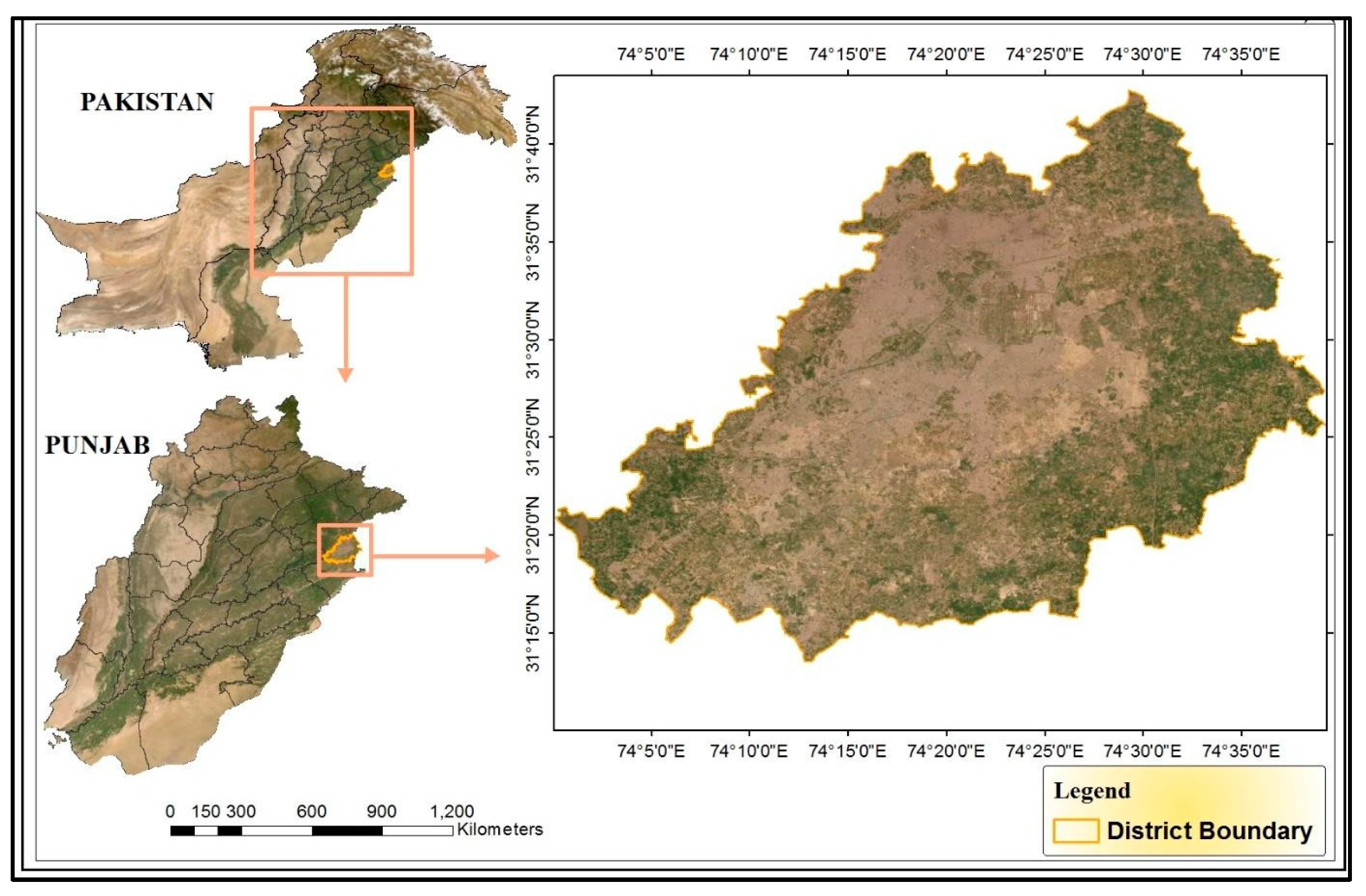
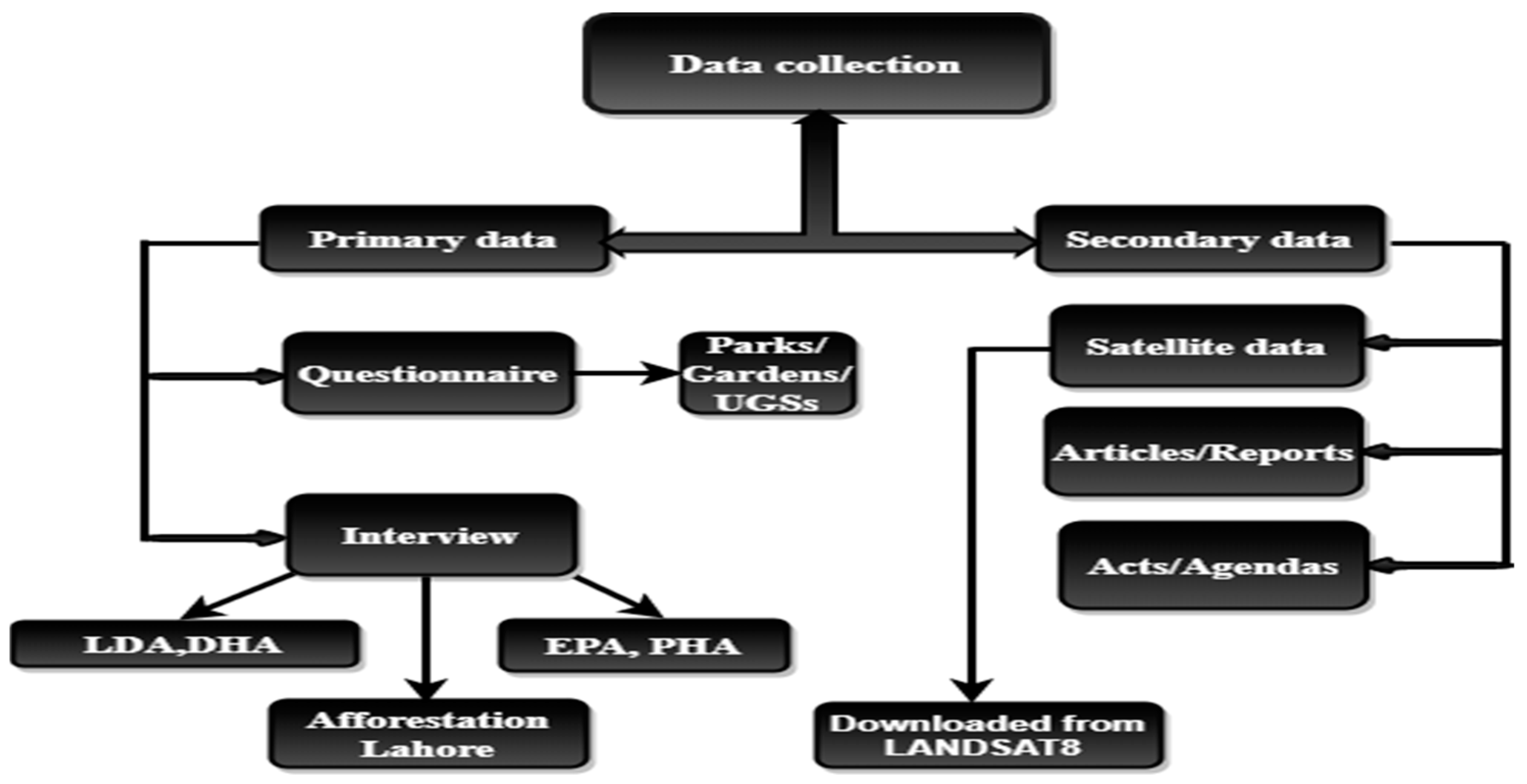

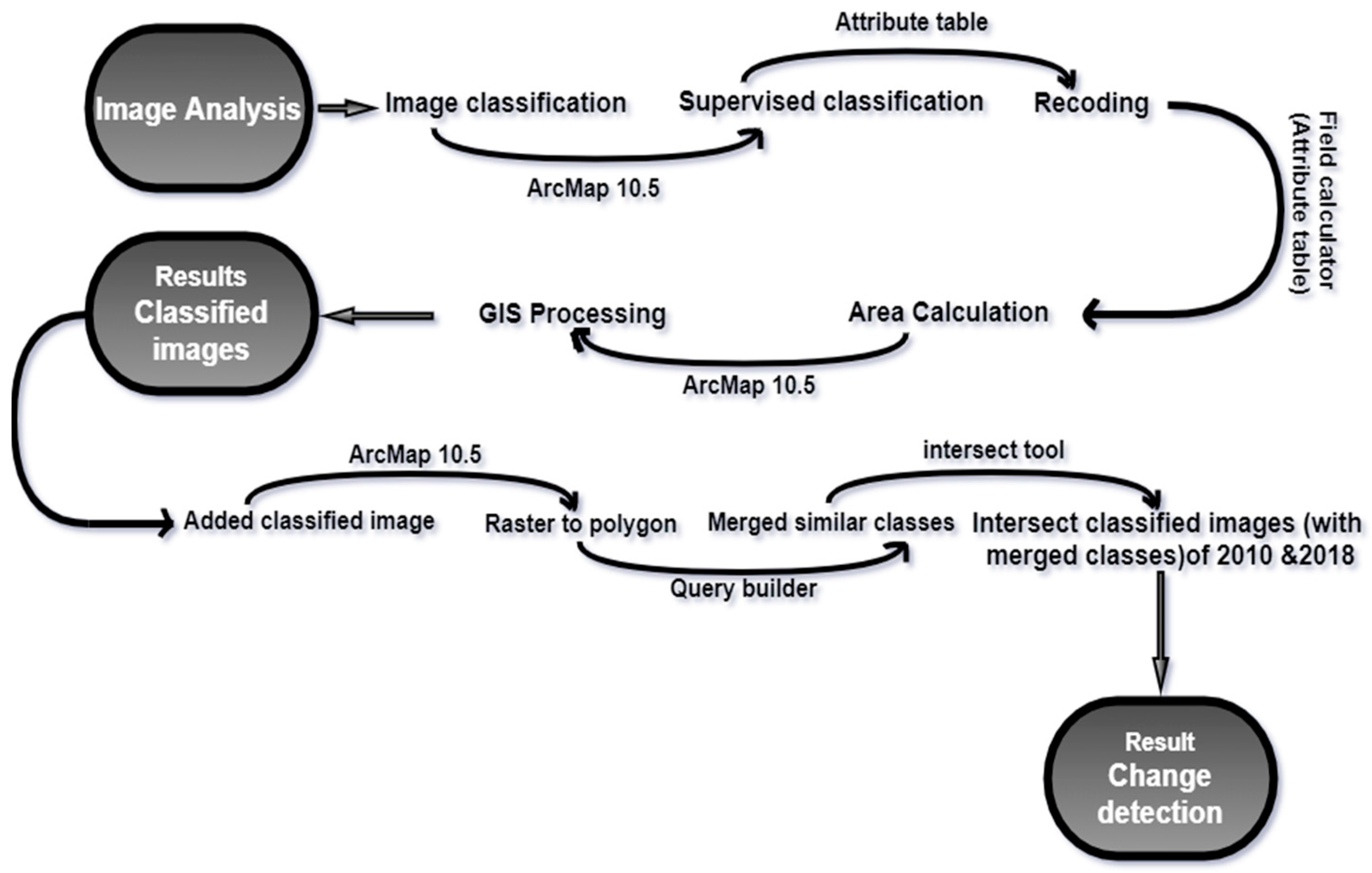
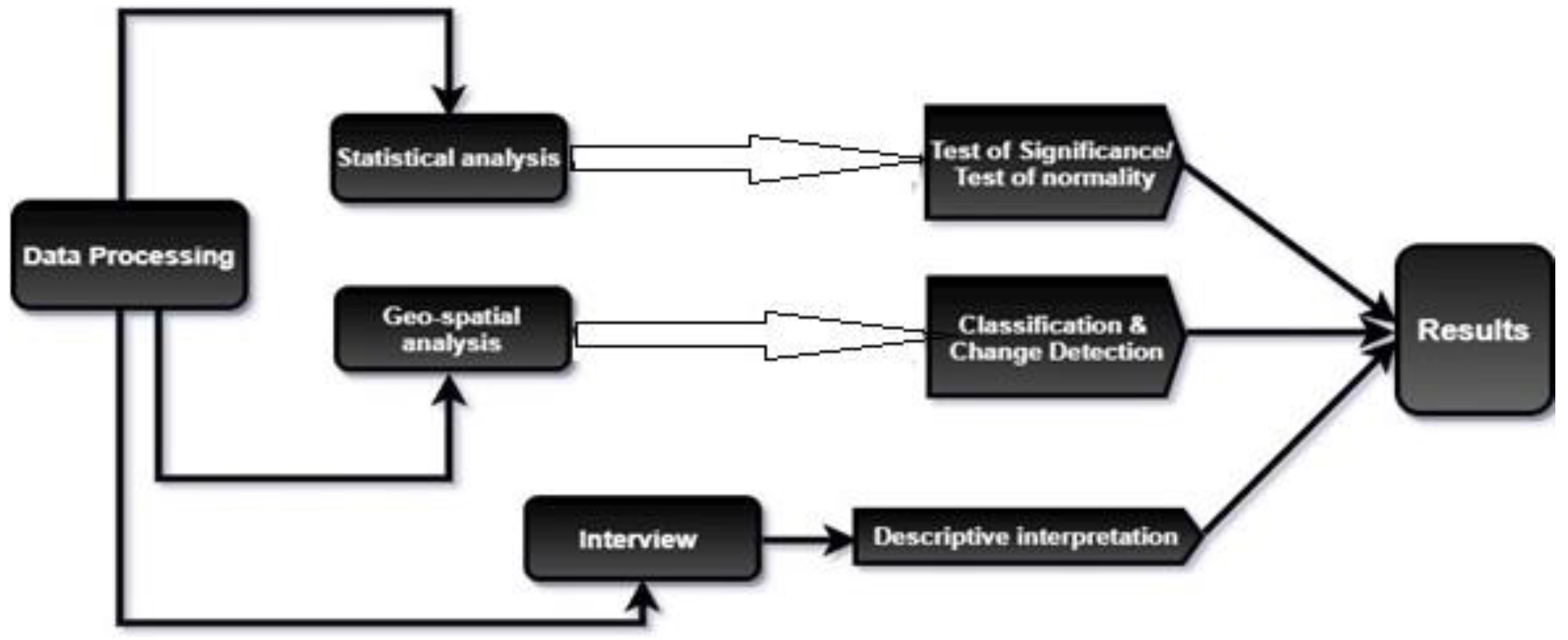

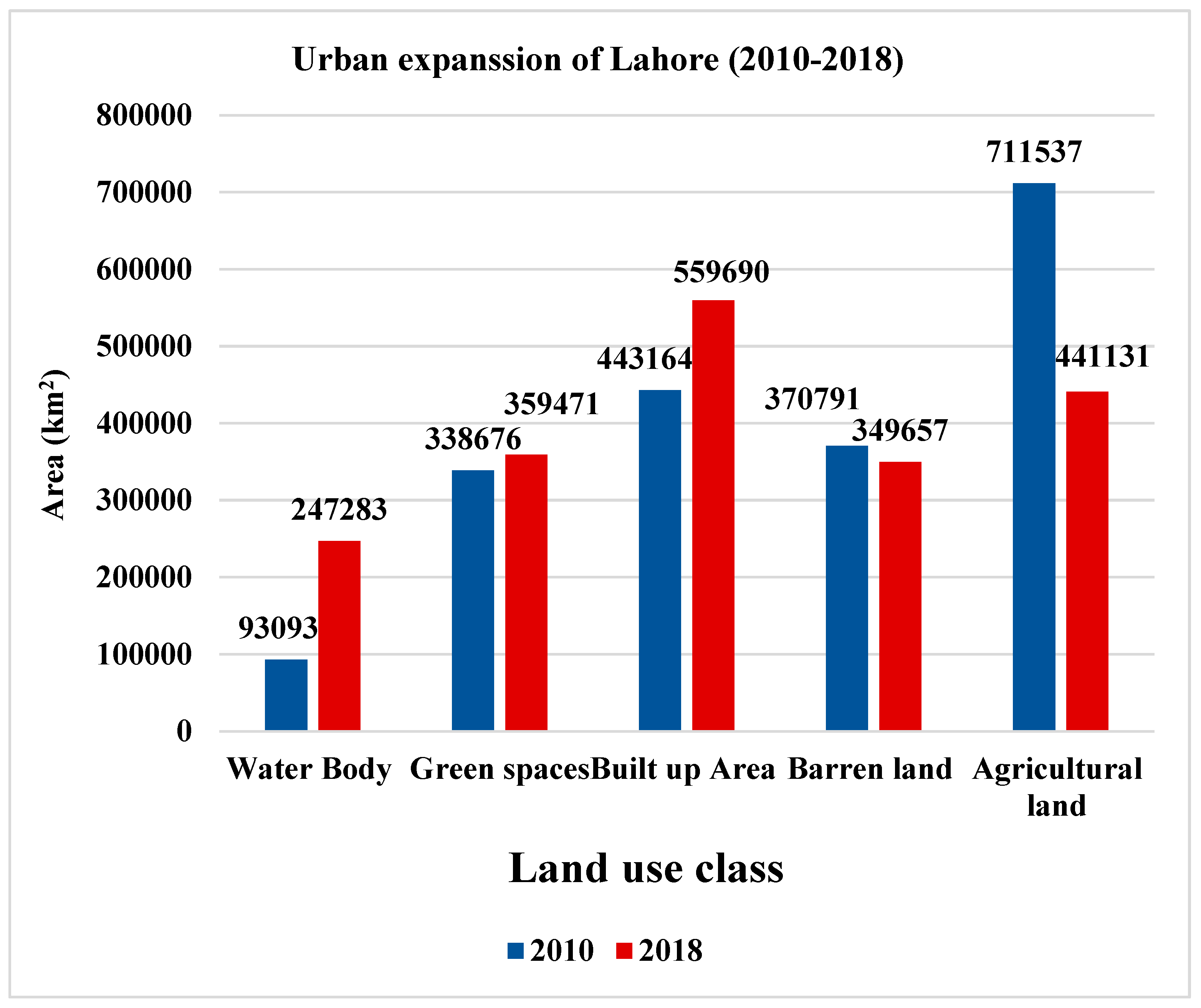
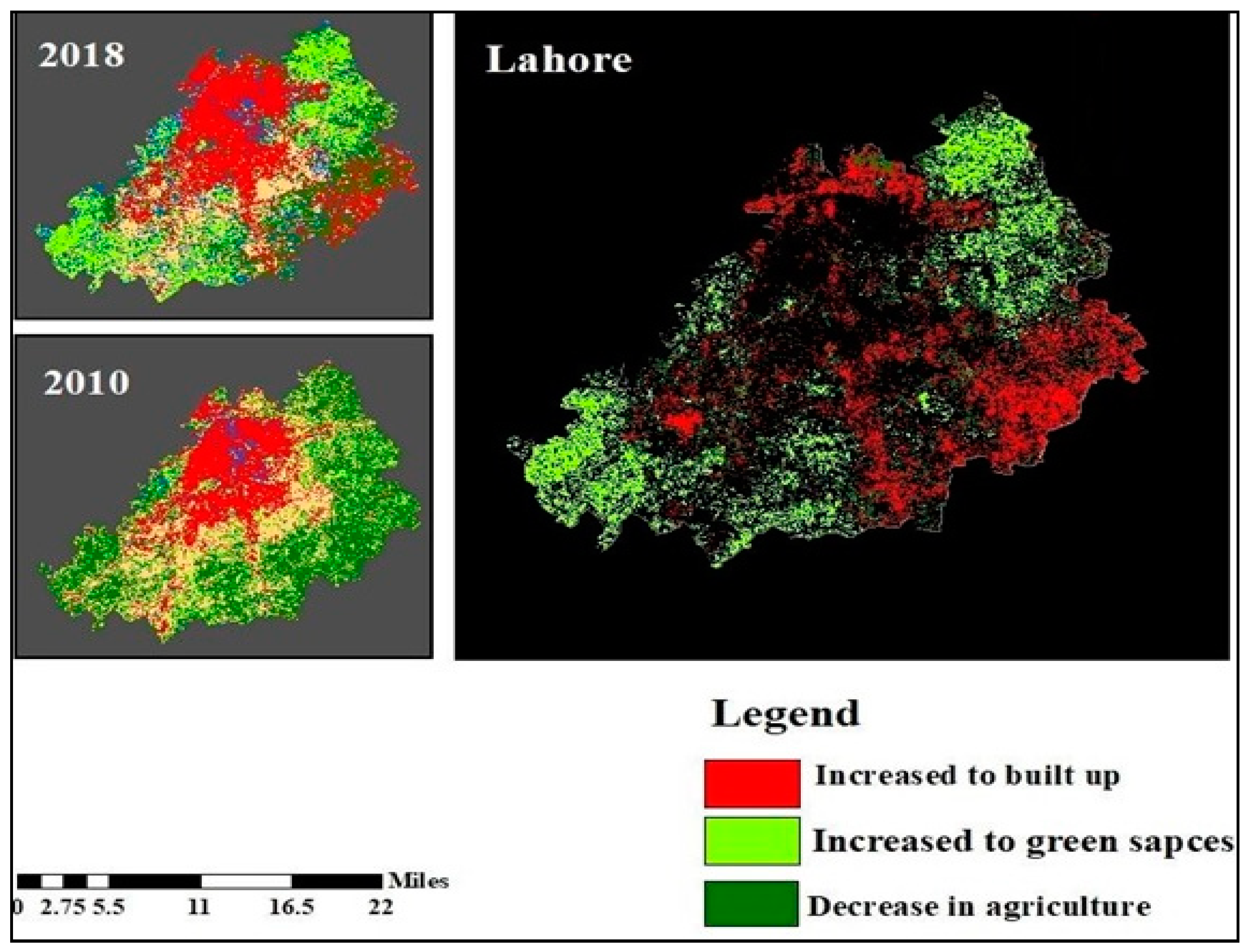
| Department | Role | Level |
|---|---|---|
| Parks & Horticulture Authority (PHA) | Environment and ecosystem protection | Provincial |
| Environment Protection Agency (EPA) | Environment protection | Provincial |
| Defense Housing Authority (DHA) | Land regulation | Federal |
| Lahore Development Authority (LDA) | Land regulation | Provincial |
| Afforestation Lahore (AL) | Plantation and afforestation | Under GOP |
| No | Urban Green Spaces (Parks/Garden etc.) | Monitoring Level |
|---|---|---|
| 1 | Jilani park | PHA |
| 2 | Gulshan Iqbal park | PHA |
| 3 | Bhagh-e-Jinnah | PHA |
| 4 | Jam-e-Shiren park | Local |
| 5 | Greater Iqbal park | PHA |
| 6 | Nwaz Sharif park | Local |
| 7 | National park | PHA |
| 8 | Arfa Karim park | PHA |
| 9 | Kalma chowk garden | PHA |
| 10 | Nasir bhagh | PHA |
| 11 | Jallo park | PHA |
| 12 | Sozo water park | PHA |
| 13 | Nishtar park | PHA |
| 14 | Model town park | Local |
| 15 | Hazuri bhagh | PHA |
| 16 | Victoria park | PHA |
| 17 | Saint Mary park | Local |
| 18 | Sheeba park | PHA |
| 19 | Askari park | DHA |
| 20 | Babar park | Local |
| Land Use Class | Area (m2) 2010 | Area (m2) 2018 |
|---|---|---|
| Built-up area | 443,164 | 559,690 |
| Agricultural land | 711,537 | 441,131 |
| Green space | 338,676 | 359,471 |
| Barren land | 370,791 | 349,657 |
| Water body | 93,093 | 247,283 |
| Test Value = 65 | ||||||
|---|---|---|---|---|---|---|
| T | df | Sig | Mean Difference | 95% Confidence Interval | ||
| Lower | Upper | |||||
| Most visitors | −230.240 | 24 | 0.000 | −23.480 | −23.69 | −23.27 |
| No. of visitors in the past 5 years | −142.648 | 24 | 0.000 | −24.320 | −24.67 | −23.97 |
| Regular monitoring | −188.737 | 24 | 0.000 | −24.560 | −24.83 | −24.29 |
| Effect of change in government on policies | −168.291 | 24 | 0.000 | −23.800 | −24.09 | −23.51 |
| Corruption | −24.275 | 24 | 0.000 | −23.640 | −23.84 | −23.44 |
| Effect of political instability on the flow of funds | −201.391 | 24 | 0.000 | −24.720 | −24.97 | −24.47 |
Disclaimer/Publisher’s Note: The statements, opinions and data contained in all publications are solely those of the individual author(s) and contributor(s) and not of MDPI and/or the editor(s). MDPI and/or the editor(s) disclaim responsibility for any injury to people or property resulting from any ideas, methods, instructions or products referred to in the content. |
© 2025 by the authors. Licensee MDPI, Basel, Switzerland. This article is an open access article distributed under the terms and conditions of the Creative Commons Attribution (CC BY) license (https://creativecommons.org/licenses/by/4.0/).
Share and Cite
Khalid, A.; Anwar, M.; Mazhar, U. Inadequate Governance of Urban Ecosystems in Lahore, Pakistan: Insights from Changes in Land Use. Urban Sci. 2025, 9, 162. https://doi.org/10.3390/urbansci9050162
Khalid A, Anwar M, Mazhar U. Inadequate Governance of Urban Ecosystems in Lahore, Pakistan: Insights from Changes in Land Use. Urban Science. 2025; 9(5):162. https://doi.org/10.3390/urbansci9050162
Chicago/Turabian StyleKhalid, Arsla, Momina Anwar, and Usman Mazhar. 2025. "Inadequate Governance of Urban Ecosystems in Lahore, Pakistan: Insights from Changes in Land Use" Urban Science 9, no. 5: 162. https://doi.org/10.3390/urbansci9050162
APA StyleKhalid, A., Anwar, M., & Mazhar, U. (2025). Inadequate Governance of Urban Ecosystems in Lahore, Pakistan: Insights from Changes in Land Use. Urban Science, 9(5), 162. https://doi.org/10.3390/urbansci9050162








